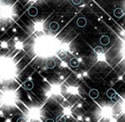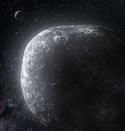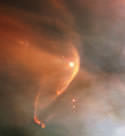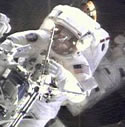
Image credit: Hubble
Thanks to the Hubble Space Telescope, astronomers are using ancient stars in the Milky Way to come up with an independent estimate about the age of the Universe. In the past, astronomers have calculated this age using its rate of expansion, and pegged it between 13-14 billion years old. Under this new method, the astronomers targeted ancient white dwarf stars which cool down at a very predictable rate. These stars were formed near the beginning of the Universe, and the astronomers were able to estimate that they are between 12-13 billion years old. Close enough.
Pushing the limits of its powerful vision, NASA’s Hubble Space Telescope has uncovered the oldest burned-out stars in our Milky Way Galaxy. These extremely old, dim “clockwork stars” provide a completely independent reading on the age of the universe without relying on measurements of the expansion of the universe.
The ancient white dwarf stars, as seen by Hubble, turn out to be 12 to 13 billion years old. Because earlier Hubble observations show that the first stars formed less than 1 billion years after the universe’s birth in the big bang, finding the oldest stars puts astronomers well within arm’s reach of calculating the absolute age of the universe.
Though previous Hubble research sets the age of the universe at 13 to 14 billion years based on the rate of expansion of space, the universe’s birthday is such a fundamental and profound value that astronomers have long sought other age-dating techniques to cross-check their conclusions. “This new observation short-circuits getting to the age question, and offers a completely independent way of pinning down that value,” says Harvey Richer of the University of British Columbia, Canada.
The new age-dating observations were done by Richer and colleagues by using Hubble to go hunting for elusive ancient stars hidden inside a globular star cluster located 5,600 light-years away in the constellation Scorpius. The results are to be published in the Astrophysical Journal Letters.
Conceptually, the new age-dating observation is as elegantly simple as estimating how long ago a campfire was burning by measuring the temperature of the smoldering coals. For Hubble, the “coals” are white dwarf stars, the burned out remnants of the earliest stars that formed in our galaxy.
Hot, dense spheres of carbon “ash” left behind by the long-dead star’s nuclear furnace, white dwarfs cool down at a predictable rate ? the older the dwarf, the cooler it is, making it a perfect “clock” that has been ticking for almost as long as the universe has existed.
This approach has been recognized as more reliable than age-dating the oldest stars still burning by nuclear fusion, which relies on complex models and calculations about how a star burns its nuclear fuel and ages. White dwarfs are easier to age-date because they are simply cooling, but the trick has always been finding the dimmest and hence longest-running “clocks.”
As white dwarfs cool they grow fainter, and this required that Hubble take many snapshots of the ancient globular star cluster M4. The observations amounted to nearly eight days of exposure time over a 67-day period. This allowed for even fainter dwarfs to become visible, until at last the coolest ? and oldest ? dwarfs were seen. These stars are so feeble (at 30th magnitude ? which is considerably fainter than originally anticipated for any Hubble telescope imaging with the original cameras), they are less than one-billionth the apparent brightness of the faintest stars that can be seen by the naked eye.
Globular clusters are the first pioneer settlers of the Milky Way. Many coalesced to build the hub of our galaxy and formed billions of years before the appearance of the Milky Way’s magnificent pinwheel disk (as further confirmed by Richer’s observations). Today 150 globular clusters survive in the galactic halo. The globular cluster M4 was selected because it is the nearest to Earth, so the intrinsically feeblest white dwarfs are still apparently bright enough to be picked out by Hubble.
In 1928, Edwin Hubble’s measurements of galaxies made him realize that the universe was uniformly expanding, which meant the universe had a finite age that could be estimated by mathematically “running the expansion backward.” Edwin Hubble first estimated the universe was only 2 billion years old. Uncertainties over the true expansion rate led to a spirited debate in the late 1970s, with estimates ranging from 8 billion to 18 billion years. Estimates of the ages of the oldest normal “main-sequence” stars were at odds with the lower value, since stars could not be older than the universe itself.
In 1997 Hubble astronomers broke this impasse by triumphantly announcing a reliable age for the universe, calculated from a very precise measurement of the expansion rate. The picture soon got more complicated when astronomers using Hubble and ground-based observatories discovered the universe was not expanding at a constant rate, but accelerating due to an unknown repulsive force termed “dark energy.” When dark energy is factored into the universe’s expansion history, astronomers arrive at an age for the universe of 13-14 billion years. This age is now independently verified by the ages of the “clockwork” white dwarfs measured by Hubble.
Original Source: Hubble News Release



